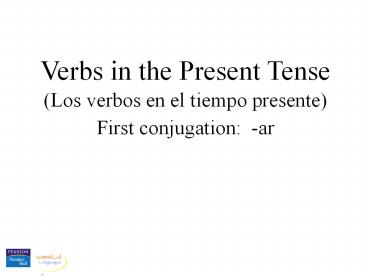Present tense, -ar verbs - PowerPoint PPT Presentation
Title:
Present tense, -ar verbs
Description:
Verbs in the Present Tense (Los verbos en el tiempo presente) First conjugation: -ar The fundamental parts of the Spanish verb The infinitive: The basic, unconjugated ... – PowerPoint PPT presentation
Number of Views:158
Avg rating:3.0/5.0
Title: Present tense, -ar verbs
1
Verbs in the Present Tense
(Los verbos en el tiempo presente)
First conjugation -ar
2
The fundamental parts of the Spanish verb
1
- The infinitive The basic, unconjugated form,
the one that corresponds to the English to do
(something). For example, to speak, to work, to
sing, etc.
The Spanish infinitive always ends in r
3
The fundamental parts of the Spanish verb
The Spanish infinitive always ends in r
hablar comer escribir cantar aprender leer
salir conocer costar correr finalizar freír
4
The fundamental parts of the Spanish verb
2
- The ending The last two letters of the
infinitive.
The ending always consists of two letters.
5
The fundamental parts of the Spanish verb
The ending always consists of two letters
hablar comer escribir cantar aprender leer
hablar comer escribir cantar aprender leer
salir conocer costar correr finalizar freír
salir conocer costar correr finalizar freír
There are three types or categories of verbs in
Spanish
those that end in ar,
those that end in er,
and those that end in ir
6
The fundamental parts of the Spanish verb
3
- The stem or root Whatever is left after
removing the ending from the infinitive.
The stem can consist of a variable number of
letters, depending on the length of the verb in
question.
7
The fundamental parts of the Spanish verb
The infinitive the ending the stem
salir conocer costar correr finalizar freír
hablar comer escribir cantar aprender leer
8
The fundamental parts of the verb
No te olvides! Don't forget!
1
- The infinitive The basic, unconjugated form of
the verb.
estudiar
The ending The last two letters of the
infinitive.
2
ar
The stem What is left after taking the ending
from the infinitive.
3
estudi
9
Verb Conjugation
To conjugate To put a verb in its correct
person and number so that we know who is doing
the action.
When we conjugate any verb we always begin with
its stem.
10
Verbs of the 1st conjugation (-ar)
The following verbs are regular -ar verbs and are
conjugated according to the pattern in the
following slides.
hablar
to speak
llegar
to arrive
to look at
ayudar
to help
mirar
bailar
to dance
nadar
to swim
buscar
to look for
necesitar
to need
caminar
to walk
preparar
to prepare
to buy
comprar
regresar
to return
conversar
to converse
tomar
to take or to drink
enseñar
to teach
escuchar
to listen
trabajar
to work
estudiar
to study
viajar
to travel
11
Verbs of the 1st conjugation (-ar)
- hablar
All persons and numbers are based on the stem.
yo
nosotros/as
a
a
h
bl
o
a
habl
mos
a
vosotros/as
tú
a
h
bl
as
a
á
habl
is
á
a
h
bl
a
a
a
h
bl
an
a
Notice which vowel gets the emphasis!
12
Verbs of the 1st conjugation (-ar)
- trabajar
Its stem?
a
a
trab
j
o
a
trabaj
mos
a
a
trab
j
as
a
á
trabaj
is
á
a
trab
j
a
a
a
trab
j
an
a
The emphasis?
13
Verbs of the 1st conjugation (-ar)
- buscar
Its stem?
a
u
b
sc
o
u
busc
mos
a
u
b
sc
as
u
á
busc
is
á
u
b
sc
a
u
u
b
sc
an
u
The emphasis?
14
Verbs of the 1st conjugation (-ar)
- estudiar
Its stem?
a
u
est
di
o
u
estudi
mos
a
u
est
di
as
u
á
estudi
is
á
u
est
di
a
u
u
est
di
an
u
The emphasis?
15
Verb usage
The Spanish present indicative tense has several
equivalents in English.
As in English, it can express present habitual
actions
Estudiamos español en la universidad.
We study Spanish at the university.
But, unlike English, it can also express ongoing
actions
En este momento estudiamos en la biblioteca.
Right now were studying in the library.
It can even express future actions
Esta noche estudiamos para el examen.
Tonight we will study for the exam.
16
- La biblioteca es un buen lugar para estudiar.
Estudio matemáticas.
Qué estudias?
Verb forms that refer to people that are within
the conversation flip to their opposite form.
estudio estudiamos estudias estudiáis estudia e
studian
Qué estudias tú?
17
- La biblioteca es un buen lugar para estudiar.
Estudia filosofía.
Qué estudia Juan?
Verb forms that refer to people that are outside
the conversation do not change.
estudio estudiamos estudias estudiáis estudia e
studian
18
FIN































